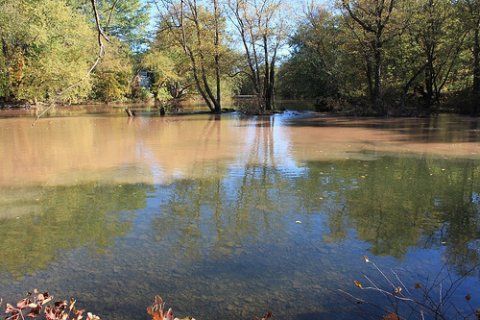
The photo above bears more than a passing resemblance to the Meeting of the Waters, the famous spot in the Brazilian Amazon where the muddy "white" water of the Solimoes flows into the "black" water of the Rio Negro. But no: It's the Lower Esopus Creek, where it meets the Saw Kill. That's what you get when the NYC DEP releases 4.4 billion gallons of muddy effluent into the dry Esopus over little more than a week.
Local towns and environmentalists have long been frustrated with the DEP's treatment of the Lower Esopus (and the Upper Esopus as well, upstream from the Ashokan). In recent years, massive stormwater releases from the Ashokan has left the Lower Esopus oscillating between a muddy torrent and a dry, stony bed. Now, locals are taking further steps to enlist Albany in the effort to force DEP to release more clean water into the river. The Times Herald-Record's Adam Bosch reports:
The Lower Esopus Watershed Partnership — a team of local governments and environment advocates — is pushing New York City to release more clean water from its reservoir system to improve the ailing Lower Esopus.
In September, the group delivered a letter to state regulators, asking them to force New York City to release more clean water from the Ashokan Reservoir into the creek. It suggested making those daily releases a requirement of the city's pollution discharge permit, which expires at the end of 2011.
Bosch, the THR's environmental beat reporter, recently started a new blog focused on environmental issues throughout the Catskills/Hudson Valley region. It's called Enviro-Watch, and you can check it out here. The inaugural post? A roundup of some of the background that didn't quite fit into his main story for the THR. Bosch points out that when the DEP keeps the lower Esopus muddy or lets it dry up, it's not just the river that suffers: Downstream users, including local farmers and the town of Ulster's sewage treatment plant, have a vested interest in the Esopus running clean.
Farmers use water from the Lower Esopus to irrigate their crops. But when NYC discharges turbid water into the creek, farmers fear they could violate Good Agricultural Practices standards that allow them to sell their food on the market. The cleanliness of water is one of the factors that determines whether a farm gets the GAP seal of approval. And the GAP seal of approval can determine whether your farm thrives or dives.
Photo submitted by THR reader. Courtesy of Adam Bosch.














